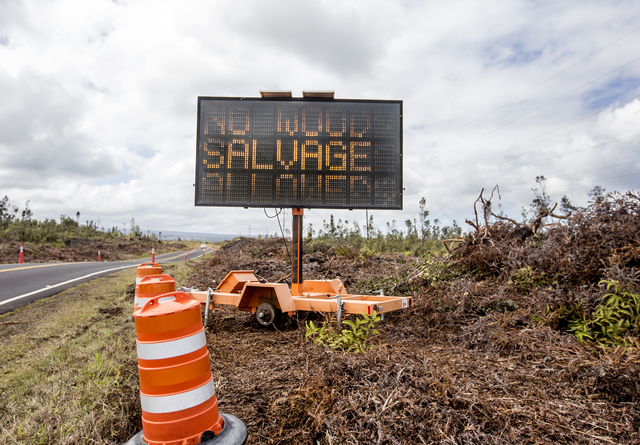State and federal officials are advising residents to not take timber from a highway work site as construction crews finish improvements on a portion of Saddle Road outside of Hilo. ADVERTISING State and federal officials are advising residents to not
State and federal officials are advising residents to not take timber from a highway work site as construction crews finish improvements on a portion of Saddle Road outside of Hilo.
Removing timber could increase risk of spreading the fungus (Ceratocystis fimbriata) responsible for rapid ohia death, the disease that has infected more than 34,000 acres of native ohia trees on Hawaii Island.
There is no cure for the disease, which was first observed in 2010. Once infected, a tree can die in a matter of days.
According to the Hawaii Department of Transportation, a portion of Saddle Road is being realigned, requiring that vegetation in the area be cleared.
HDOT developed protocol for minimizing transmission of Ceratocystis fimbriata, such as sanitation of tools and containing ohia within the project area, by working with the groups already involved in combating the spread of rapid ohia death.
“Experts agree that the most immediate action to prevent … acceleration of the fungus’ spread is to restrict movement of infected ohia trees,” HDOT said in a written statement.
Since the site clearing began, however, “Several individuals have made … requests to take vegetation from the project site.” There have also been instances of “individuals hauling timber from the work area.”
Removing the wood jeopardizes the containment precautions.
HDOT officials could not be reached by press time for further details.
A Hawaii Department of Agriculture permit is now required to move ohia between islands. Other efforts to contain the spread of rapid ohia death have ranged from discouraging halau at Merrie Monarch from using the tree in costumes and displays to appropriations of additional state funding.
On Friday, legislators approved $300,000 from the state general fund for rapid ohia death research.
Lawmakers have not yet decided which agency will manage the funds.
Money could be used for hiring additional pathology researchers as well as supplies for pathogen detection, according to the bill.
The Associated Press contributed to this report.
Email Ivy Ashe at iashe@hawaiitribune-herald.com.



